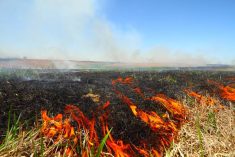It’s been one year since Alberta’s controversial farm and ranch safety legislation came into effect, and the jury is still out as to whether the act is actually making farms across the province safer.
But preventing agriculture-related injuries is “pretty complex,” and legislation alone can’t bear that load without some support from training and education, said farm safety expert Donna Trottier.
“Legislating common sense has proven to be beneficial, with things like seatbelt legislation that has kept people safer on the road — but legislation alone isn’t the most effective approach to preventing agriculture injury,” said the co-ordinator for the Alberta Farm and Ranch Safety Extension working group.
Read Also

Grazing ‘sweet spot’ boosts pasture performance
Timing-focused approach to pasture management touted to boost forage growth, livestock gains while also cutting farmer labour and inputs
“Other jurisdictions have found that simply legislating it isn’t always improving the injury statistics. It requires incorporating various strategies — education, legislation, and other levels of influence.”
Legislation has brought farm safety to the forefront of farmers’ minds.
“Everybody is talking about it because of Bill 6,” said Trottier, who is developing an industry-led farm safety program that includes educational resources and awareness tools for the working group.
“But when I talk to farmers, their reason for having farm safety programs isn’t necessarily driven by that legislation. The driving factor for farm safety is protecting people — farmers, kids, family members, employees.
“If we can find our own reasons for including safety strategies that fit the business needs on the farm, that will be the motivation for people.”
Right now in Alberta, farm safety is “all across the board,” said Trottier.
“It’s like asking how good is the average driver in Alberta. We have good drivers and we have bad drivers,” she said. “The degree of farm safety program implementation in Alberta varies widely.”
But when compared with other industries, agriculture is “probably on the lower end of the scale” for having formal safety programs in place. And farm safety often becomes just another item on a never-ending to-do list.
In a survey of 400 Alberta producers conducted by agri-food market research firm Kynetec, about 40 per cent indicated they’ve identified risks on their farms and taken action on them. However, about 20 per cent said they haven’t taken action on identified risks, another five per cent said they haven’t identified risks at all, and 35 per cent said the question was ‘not applicable.’
“Sometimes we don’t give safety the attention it deserves,” said Trottier. “We get busy with the haste of the season, and we forget to think about the risks that are involved in our daily activities.
“We all have some bad habits, and we’ve done things on the farm the same way for years. But we need to ask ourselves if that’s the safest way to do it.”
Practical strategies
That’s the basis for Trottier’s presentation on farm safety at the upcoming FarmTech Conference, which runs from Jan. 31 to Feb. 2.
“People have their own reasons why they would want to implement a safety program on their own farms, and I want my talk to help farmers identify their reasons for incorporating safety into their overall risk management strategy,” said Trottier.
“I want my talk to help them find their reasons for arguing for safety instead of against it. There’s been a lot of negative talk about farm safety, and I want this to have a positive spin and give farmers a reason to incorporate safety on their farm.”
Developing a farm safety plan can be intimidating, but Trottier hopes to provide some basic strategies to help producers get started.
“Most farmers want something that’s straightforward and really practical as a starting point for their programs,” she said. “It’s not about telling farmers how to do the job that they’re already doing. It’s more about reminding them to bring farm safety to the front of their minds and think about the hazards and the risks that we have in our daily activities.”
Farm safety plans also help farmers train other people about the hazards of working and living on the farm, she added.
“We want to make sure that the people on the farm are made aware of the hazards, the control measures they have in place for those hazards, and the procedures to follow in order to do the job safely,” she said, adding training helps prevent injuries, increase productivity, and create a strong safety culture on the farm.
“We need to consider all the risks on the farm, what we can and can’t do about those risks, and then evaluate the level of risk that we’re willing to accept as we work on the farm.”
There’s an economic benefit, too, said Trottier.
“Farmers and ranchers are managing a huge area of risk — from weather to finances — and it makes really good business sense to add that farm safety component into that overall risk management realm,” she said.
“Farmers can justify spending money on a safety program just the same as they would when buying a new piece of equipment.”
But safety programs work best if they’re “customized to the farm and developed to fit the operation,” she said.
“The best place to start is by identifying the hazards on the farm and evaluating what controls can be put in place to reduce the hazards,” said Trottier.
“We know how to grow things in agriculture. Start small with your safety program, work on your safety program over time, keep it simple, and let it grow. It doesn’t have to be complicated — just get started.”















